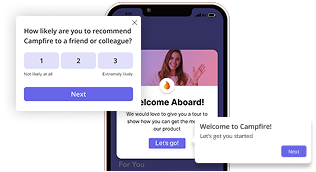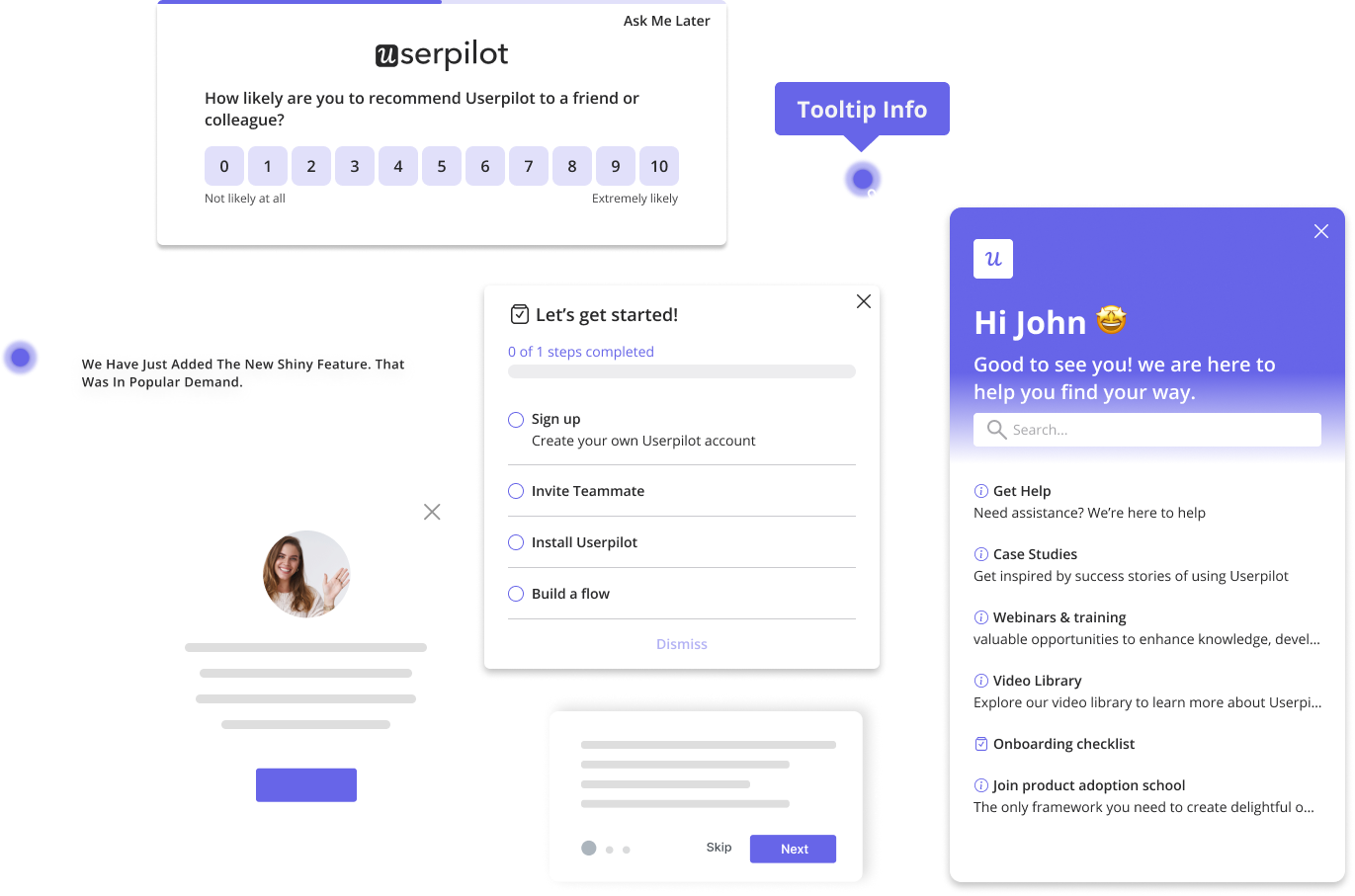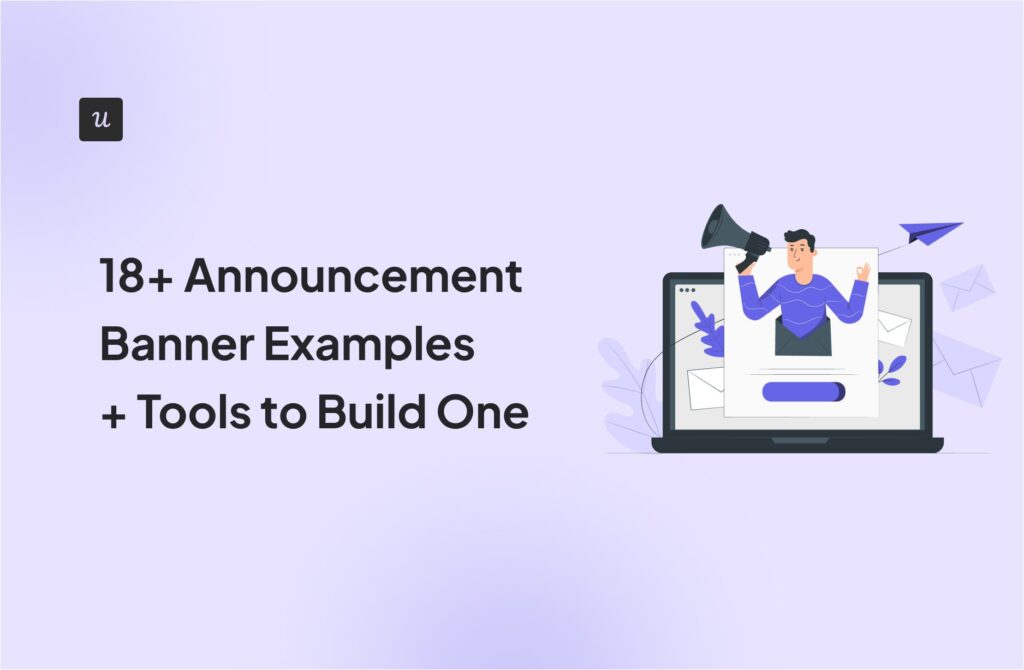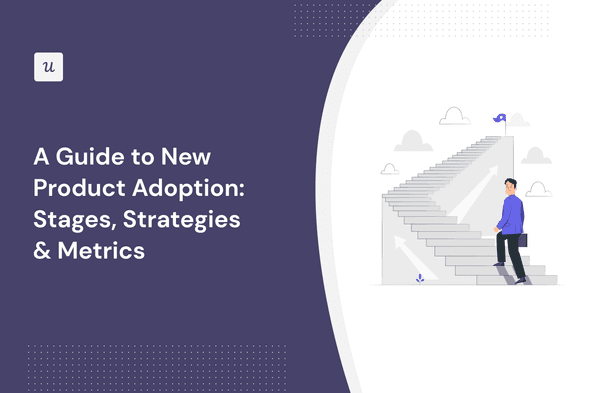
The average feature adoption rate for SaaS products is only 24.5%. This means you can spend weeks mapping user journeys and refining every interaction, but likely, only a very small percentage of users will ever interact with the features you worked so hard on.
So, here, I’m going to walk you through the key feature success strategies you need to employ and the feature adoption metrics you must track to make your new feature release impossible to ignore.
What’s your biggest challenge with a new feature launch?
How do you currently announce new features to your users?
When it comes to how to measure new feature success, which metric matters most to you?
Ready to make every feature launch a success?
You’re ready to move beyond basic analytics. See how Userpilot can help you guide users, gather feedback, and accurately measure feature success without writing any code.
Try Userpilot Now
See Why 1,000+ Teams Choose Userpilot

Why measure new feature success?
I think launching without measurement is like steering in the dark. We might move, but we won’t know if we’re headed in the right direction. From what I’ve seen, measuring the success of your launches will guide you in the following ways:
- Validate product-market fit: I’ve seen product managers love their feature idea only to have it killed because no one really needed it. I believe you need to determine whether a specific feature actually addresses a customer problem. Early user feedback reveals whether you are on target or if you need to pivot before investing more time and resources.
- Optimize resource allocation: Engineering time is limited, so I always advise wisely investing where it counts. Seeing which features resonate and which fall flat lets you reassign effort to work that drives real user engagement and value.
- Improve user satisfaction and retention: Smooth feature launches prevent frustration and encourage customers to return. Knowing exactly where users get stuck helps you eliminate friction and turn first-time clicks into lasting habits.
- Prove ROI: Hard data transforms feature launches from speculative bets into clear wins, making it easier to secure approval and funding for future projects.
- Identify opportunities for iteration: No launch is perfect, and fine-tuning is essential. Detailed analyses of user sessions show whether users drop off immediately or after repeated use, so each update delivers more value than the last.
The adoption-value equation for feature success
I believe true feature success depends on more than how many people click a button. It’s a product of adoption and the real value we deliver. If your latest feature sees a spike in users but leaves them frustrated, it won’t stick. Likewise, a brilliant tool that sits unused won’t move the needle.
User adoption x value = Feature success
Feature success comes from two factors working together:
- Reaching the right audience: A new feature must be presented in a way that meets the user’s needs. If you roll out a bulk email editor to just 10 customers, even a perfect design won’t prove viability. But if you offer it to 100 marketers who send campaigns daily, you’ll quickly see if it resonates.
- Driving understanding, perceived value, and engagement: Adoption should inform users about its purpose, help them believe it’s beneficial, and encourage them to come back and use it. When all three happen, it’s a good sign that your launch messaging and tutorials are doing their job.
It’s easy to confuse high adoption with success, but a feature that drives users nuts can trigger higher churn. And a perfectly valuable tool buried away in the product won’t pad your MRR either. Adoption and value must both be present to call a feature a win.
5 Key metrics for measuring new feature success
From my perspective, understanding and tracking user behavior demands both hard data and real feedback. If you want to measure feature adoption accurately, I recommend tracking these five key performance indicators to blend quantitative signals with qualitative insights so you know not just what happens but why it happens:
1. Feature adoption rate
What it is: The share of your active user base that has engaged with the new feature at least once.
Formula: To calculate the feature adoption rate, divide the number of the feature’s monthly active users (MAUs) by the number of user logins in a period of time, and multiply it by 100.
Why track it: Adoption rate reveals initial interest and discoverability of a particular feature. If only a small slice of users ever try a feature, I find that it may be hidden behind a confusing UI or lack clear value.
How to track it: In Userpilot, you flag that event and pull an adoption report without writing extra code. Combine this quantitative view with user interviews to gain a deeper understanding of why some users click through while others never engage.

2. Net Promoter Score (NPS)
What it is: A measure of user sentiment based on how likely users are to recommend the feature to a colleague or friend.
Formula: Total % of promoters – total % of detractors = Net Promoter Score
Why track it: NPS moves beyond click counts to capture attitudes. A high NPS indicates that your feature delights users, while a low score suggests that expectations are not being met or that there is friction.
How to track it: Deploy an in-app NPS survey after users complete a core action, like trying out a new feature. Userpilot’s survey widget captures scores and open-text feedback, allowing you to pair a quantitative score with qualitative comments on what users love or dislike. This way, you can successfully meet user expectations and offer maximum value.

3. Drop-off rate
What it is: The proportion of users who try the feature once but never return for a second session.
Formula: To calculate the drop-off rate, divide the number of users who didn’t complete a process by the number of users who started it, and multiply it by 100.
Why track it: Drop-off rate flags friction or missing value. If many users bail after the first use due to a poor first-time user experience, lack of perceived value, or unexpected friction, you know your onboarding process or core design needs rethinking.
How to track it: You can use your analytics tool to display which steps users are dropping off in an onboarding or signup process. View the amount of time it takes users to complete an action.

4. Total active users
What it is: The count of unique users engaging with your product or feature over a defined period, such as daily active users (DAU), weekly active users (WAU), or monthly active users (MAU). These metrics help you measure product stickiness; i.e., how frequently users engage with a product and how essential it becomes in their daily workflows.
Formula: To measure stickiness, you must look at (Daily Active Users / Monthly Active Users) * 100
Why track it: Raw adoption percentages can be misleading if your user base is tiny or enormous. Total active users put adoption in context and measure overall stickiness at scale.
How to track it: In Userpilot, you can create a custom dashboard to track DAUs, WAUs, or MAUs for a specific time period and analyze whether users are staying or churning early.

5. User retention rate
What it is: The percentage of users who continue to engage with the feature (or product) over successive periods.
Formula: [(Ending Customers – New Customers) / Beginning Customers] * 100 where ending customers is people ending their engagement with your product, new customers are one that newly signed on, and beginning customers are the number of customers a business has at the start of a defined period (e.g., month, quarter, year).
Why track it: User retention measures long-term value. A feature that attracts clicks but fails to bring users back will not drive lifetime revenue.
How to track it: You can define cohorts based on the date of first feature use. Use cohort reports in your analytics tool or Userpilot’s visual cohort builder to monitor how many users return week after week. Pair this with post-use surveys to learn what keeps your most loyal users engaged.

5 Practical strategies you can use today to boost new feature success
While you know how to track key metrics, it’s also crucial for us to understand how to improve them. Here are the strategies I use to drive feature adoption for our platform. I’ve included tips and ways I recommend you can use Userpilot to get your users to pay attention to your new updates:
1. Use tooltips and modals to announce new features in-app
First, make sure nobody misses your new update. You can display a modal immediately when users log in, then follow up with a tooltip pointing to the new element. Let’s say you added a new “Schedule Report” button in your analytics suite to automate weekly reporting.
If a user opens your dashboard and instantly sees a slide-out titled “Automate weekly reports” in two clicks, they click through, the tooltip fires, and they can already generate their first report.
💡 Userpilot action tip
With Userpilot, you can build these UI patterns in minutes and then tie them to events, so every announcement appears exactly when users reach that part of your app. For instance, if you’ve launched a new “search bar” feature, you can trigger a tooltip that displays the latest update and explains its functionality when both new and returning users open the home screen.

2. Guide users step by step with contextual walkthroughs
Once users know a feature exists, they need hands-on guidance to feel confident. Spin up a two-step contextual walkthrough that highlights core actions, like selecting a date range, then clicking “Generate Preview,” right in the flow they’re already in.
For instance, when a user clicks “Generate Preview” for the first time, a hotspot appears on the date selector saying, “Choose your timeframe.” They receive a tooltip explaining the benefits of the preview. This mini-tour turns guesswork into clarity for your users.
💡 Userpilot action tip
Userpilot’s visual builder lets you tag UI elements and sequence tooltips without writing a single line of code. You can also use our AI writing feature to improve your messaging and ensure you convey your feature value in the right way. Additionally, you can optimize your writing, summarize your text, and fix minor errors, saving you time on in-app content creation.

3. Tailor your message with smart segmentation
A one-size-fits-all intro to your product falls flat because every user is unique and deserves a tailored experience. Instead, I recommend segmenting users based on their role or usage. Send new trial users a beginner’s guide to your reporting feature while power users get advanced tips on customizing their dashboards, for example.
💡 Userpilot action tip
Userpilot’s user segmentation engine handles the logic, allowing you to segment users based on characteristics such as location, gender, age, and more, and deliver the precisely right tour to each group. For example, when an enterprise admin logs in, you can trigger a modal that dives into governance settings, while a marketer on a starter plan sees a quick GIF on embedding reports in emails.

4. Spark excitement with gamification elements
Turning feature exploration into a game can drive adoption. Map out the three key steps: setup, first use, and share, and overlay a progress bar that fills as users complete each milestone.
Adding gamification results in a significant 100%-150% increase in user engagement. One way to demonstrate this is when a user completes step two: the bar advances to 66 percent, and a small “Nice work!” badge appears. That little win hooks their curiosity and nudges them to complete the next step.
💡 Userpilot action tip
Using Userpilot’s no-code checklist and badge widgets to keep users engaged by connecting these visual rewards to real events, so when users interact, every click feels like leveling up. Plus, you can also localize these checklists based on region and language to offer a more personalized experience.

5. Keep the momentum with continuous feedback loops
Launching a feature isn’t a one-and-done affair; you need to know how it’s landing. After a user’s third interaction with your new feature, fire off a two-question survey asking, “Was this easy to use?” and “What would make it better?”
Collecting those insights in real-time reveals user friction you didn’t even know existed and shows customers that you care enough to iterate quickly.
💡 Userpilot action tip
With Userpilot’s no-code survey widgets, you decide who sees the prompts and at what stage in their user journey. Next, you can pull all responses into one dashboard for easy and rapid follow-through.

Making feature success measurable and actionable
You’ve learned how adoption and value combine to define a winning feature and seen how to track feature adoption metrics that spotlight where your users thrive or hit roadblocks. Now, it’s time to put those insights to work. Set up your event tracking and in-app surveys, then watch adoption rate, NPS, drop-off, and retention cohorts to uncover exactly where to tweak your feature flow.
With Userpilot, you can tag key actions, fire contextual guidance, and gather feedback, all without writing code. That means faster data, clearer user signals, and more timely improvements. Ready to turn every release into a reliably successful feature launch? Book a demo today and see how Userpilot helps you improve feature adoption and customer retention rate.
FAQ
What metrics would you track to measure the success of a new feature launch?
Begin by defining what this feature is intended to achieve. Ask yourself:
- What problem are we solving for our users?
- Which user action should shift once this feature is live?
- How will that shift move the needle on revenue, retention, or satisfaction?
For instance, if you want to add a new “@tag” feature to collaborate with your team members in your workspace, you must identify the pain points users currently face when collaborating with their team, whether it drives incentive to use the platform more, and whether users even require this feature.
What are the 3 As of metrics?
The 3 As of product adoption metrics are: Actionable, Accessible, and Auditable.
- Actionable: Provides clear insights that directly inform the next steps you should take.
- Accessible: Easy for everyone on your team to find, understand, and use without specialized skills.
- Auditable: Can be traced back to reliable data sources so you can verify its accuracy at any time.
What is a good adoption rate for a new feature?
As per our Product Metrics Benchmark Report 2024 we found that a good adoption rate across SaaS companies is 24.5%.








